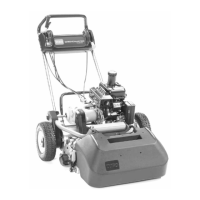Safety
T his mac hine meets or ex ceeds CEN standard
EN 836:1997, ISO standard 5395:1990, and ANSI
B71.4-1999 specifications in effect at the time of
production when the Operator Presence Kit, P ar t
No . 105-5333 is installed.
Improper use or maintenance b y the operator or
o wner can result in injur y . T o reduce the potential
for injur y , comply with these safety instr uctions
and alw a ys pa y attention to the safety aler t
symbol, whic h means CA UTION , W ARNING , or
D ANGER-“personal safety instr uction." F ailure
to comply with the instr uction ma y result in
personal injur y or death.
Safe Operating Practices
T he follo wing instr uctions are from the CEN
standard EN 836:1997, ISO standard 5395:1990,
and ANSI B71.4-1999.
Training
• R ead the Operator’ s Man ual and other training
material carefully . Be familiar with the
controls , safety signs , and the proper use of the
equipment.
• Nev er allo w c hildren or people unfamiliar with
these instr uctions to use or ser vice the mo w er .
Local regulations ma y restrict the ag e of the
operator .
• Nev er mo w while people , especially c hildren,
or pets are nearb y .
• K ee p in mind that the operator or user is
responsible for accidents or hazards occur ring
to other people or their proper ty .
• T he o wner/user can prev ent and is responsible
for accidents or injuries occur ring to himself
or herself , other people , or proper ty .
Preparation
• W hile mo wing, alw a ys w ear substantial
footw ear , long trousers , hard hat, safety glasses ,
and ear protection. Long hair , loose clothing,
or jew elr y ma y g et tangled in mo ving par ts . Do
not operate the equipment when barefoot or
w earing open sandals .
• T horoughly inspect the area where the
equipment is to be used and remo v e all objects
whic h ma y be thro wn b y the mac hine .
• W ar ning-Fuel is highly flammable . T ak e the
follo wing precautions:
– Store fuel in containers specifically designed
for this pur pose .
– R efuel outdoors only and do not smok e
while refuelling .
– Add fuel before star ting the engine . Nev er
remo v e the cap of the fuel tank or add fuel
while the engine is r unning or when the
engine is hot.
– If fuel is spilled, do not attempt to star t the
engine but mo v e the mac hine a w a y from
the area of spillag e and a v oid creating any
source of ignition until fuel v apors ha v e
dissipated.
– R e place all fuel tanks and container caps
securely .
• R e place faulty silencers .
• Ev aluate the ter rain to deter mine what
accessories and attac hments are needed to
properly and safely perfor m the job . Only use
accessories and attac hments appro v ed b y the
man ufacturer .
• Chec k that operator’ s presence controls ,
safety switc hes and shields are attac hed and
functioning properly . Do not operate unless
they are functioning properly .
Operation
• Do not operate the engine in a confined space
where dang erous carbon mono xide fumes can
collect.
• Mo w only in da ylight or in g ood ar tificial light.
• Before attempting to star t the engine ,
diseng ag e all blade attac hment clutc hes , shift
into neutral, and eng ag e the parking brak e .
• Do not use on slopes of more than 15°.
• R emember there is no suc h thing as a safe
slope . T ra v el on g rass slopes requires par ticular
care . T o guard ag ainst o v er tur ning:
– do not stop or star t suddenly when g oing
up or do wnhill;
– eng ag e clutc h slo wly , alw a ys k ee p mac hine
in g ear , especially when tra v elling do wnhill;
4

